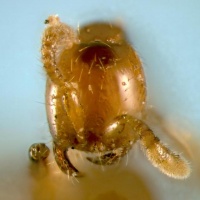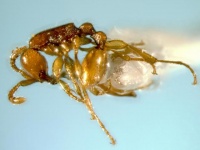Aenictus nishimurai
| Aenictus nishimurai | |
|---|---|

| |
| Scientific classification | |
| Kingdom: | Animalia |
| Phylum: | Arthropoda |
| Class: | Insecta |
| Order: | Hymenoptera |
| Family: | Formicidae |
| Subfamily: | Dorylinae |
| Genus: | Aenictus |
| Species: | A. nishimurai |
| Binomial name | |
| Aenictus nishimurai Terayama & Kubota, 1993 | |
No biological information is available for Aenictus nishimurai. However, judging from the localities cited above this species is distributed from lowland to highland (200-1,500 m) and inhabits primary, secondary and disturbed forests. (Jaitrong & Yamane 2012)
Identification
A member of the javanus species group. This species is most similar to Aenictus doydeei (see under that species).
Keys including this Species
Distribution
Latitudinal Distribution Pattern
Latitudinal Range: 19.780489° to 14.9°.
| North Temperate |
North Subtropical |
Tropical | South Subtropical |
South Temperate |
- Source: AntMaps
Distribution based on Regional Taxon Lists
Oriental Region: Laos, Thailand (type locality), Vietnam.
Distribution based on AntMaps
Distribution based on AntWeb specimens
Check data from AntWeb
Countries Occupied
| Number of countries occupied by this species based on AntWiki Regional Taxon Lists. In general, fewer countries occupied indicates a narrower range, while more countries indicates a more widespread species. |

|
Estimated Abundance
| Relative abundance based on number of AntMaps records per species (this species within the purple bar). Fewer records (to the left) indicates a less abundant/encountered species while more records (to the right) indicates more abundant/encountered species. |

|
Biology
|
Castes
Known only from the worker caste.
Nomenclature
The following information is derived from Barry Bolton's Online Catalogue of the Ants of the World.
- nishimurai. Aenictus nishimurai Terayama & Kubota, 1993: 70, figs. 9, 10 (w.) THAILAND.
- Type-material: holotype worker, 10 paratype workers.
- Type-locality: holotype Thailand: Chiang Mai Prov., Doi Step (= Suthep) (1500 m.), 18.viii.1992 (M. Terayama & S. Kubota); paratypes with same data.
- Type-depositories: NIAS (holotype); NIAS, NSMT, SKYC (paratypes).
- Status as species: Jaitrong, et al. 2011: 321 (redescription); Jaitrong & Yamane, 2012: 61 (redescription); Jaitrong, Guénard, et al. 2016: 24; Khachonpisitsak, et al. 2020: 29.
- Distribution: Laos, Thailand, Vietnam.
Unless otherwise noted the text for the remainder of this section is reported from the publication that includes the original description.
Description
Worker
Jaitrong & Yamane (2012) - Paratype: TL 2.40 mm; HL 0.58 mm; HW 0.48 mm; SL 0.25 mm; ML 0.75 mm; PL 0.20 mm; CI 83; SI 53.
Larger workers (non-types, n = 7): TL 2.66-2.90 mm; HL 0.60-0.65 mm; HW 0.53-0.58 mm; SL 0.33-0.35 mm; ML 0.83-0.90 mm; PL 0.23-0.25 mm; CI 88; SI 61-64. Smaller workers (non-types, n = 4): TL 1.95-2.25 mm; HL 0.48-0.50 mm; HW 0.38-0.43 mm; SL 0.20-0.25 mm; ML 0.55-0.65 mm; PL 0.15-0.18 mm; CI 79-85; SI 53-59.
Head in full-face view longer than broad, with sides slightly convex and posterior margin almost straight or feebly concave; seen in profile occipital corner of head rounded. Antennal scape reaching midlength of head; antennal segment II almost as long as broad; III-VIII each slightly broader than long; terminal segment 2.3 times as long as broad. Anterior margin of clypeus bearing 7–10 denticles. Masticatory margin of mandible with 3 acute teeth including a large apical tooth; basal margin lacking denticles. Mesosoma seen in profile weakly convex dorsally or almost flat; in profile propodeum almost flat dorsally; suture between mesopleuron and metapleuron absent; propodeal junction dully angulated, forming an almost right angle; declivity of propodeum shallowly concave, encircled by a thin rim. Petiole nearly as long as high, its dorsal outline convex; subpetiolar process well developed, subrectangular, its ventral margin nearly straight and longer than posterior margin; postpetiole seen in profile almost as long as petiole, with round node.
Head including antennal scape entirely smooth and shiny; mandible finely striate with outer zone smooth and shiny. Dorsal and lateral surface of pronotum smooth and shiny except for anteriormost part microreticulate; mesothorax, metapleuron, and propodeum microreticulate. Petiole entirely microreticulate. Postpetiole microreticulate except for smooth and shiny area on dorsal surface.
Head and mesosoma dorsally with relatively sparse standing hairs mixed with sparse short hairs; longest pronotal hairs 0.15–0.18 mm. Head yellowish brown; mesosoma, petiole and postpetiole reddish brown; gaster yellowish brown, but paler than head.
Type Material
Jaitrong & Yamane (2012) - Holotype and 10 paratype workers NIAST, SKY Collection) from Thailand, Changmai Prov. [Chiangmai Prov.], Doi Suthep (1,500 m alt.), 18.VIII.1992, M. Terayama and S. Kubota leg. A paratype in SKY Collection was examined.
References
- Jaitrong, W. & Yamane, S. (2012) Review of the Southeast Asian species of the Aenictus javanus and Aenictus philippinensis species groups (Hymenoptera, Formicidae, Aenictinae). ZooKeys 193: 49–78, doi: 10.3897/zookeys.193.2768.
- Jaitrong, W., Yamane, S. & Chanthalangsy, N. (2011) The ant genus Aenictus from Laos, with description of a new species (Hymenoptera: Formicidae: Aenictinae). Journal of Asia-Pacific Entomology 14, 317-322.
- Khachonpisitsak, S., Yamane, S., Sriwichai, P., Jaitrong, W. 2020. An updated checklist of the ants of Thailand (Hymenoptera, Formicidae). ZooKeys 998, 1–182 (doi:10.3897/zookeys.998.54902).
- Terayama, M.; Kubota, S. 1993. The army ant genus Aenictus (Hymenoptera: Formicidae) from Thailand and Viet Nam, with descriptions of three new species. Bull. Biogeogr. Soc. Jpn. 48: 68-72 (page 70, figs. 9, 10 worker described)
References based on Global Ant Biodiversity Informatics
- Borowiec M. L. 2016. Generic revision of the ant subfamily Dorylinae (Hymenoptera, Formicidae). ZooKeys 608: 1–280.
- Eguchi K., B. T. Viet, and S. Yamane. 2014. Generic Synopsis of the Formicidae of Vietnam (Insecta: Hymenoptera), Part IICerapachyinae, Aenictinae, Dorylinae, Leptanillinae, Amblyoponinae, Ponerinae, Ectatomminae and Proceratiinae. Zootaxa 3860: 001-046.
- Jaitrong W. 2015. A revision of the Thai species of the ant genus Aenictus Shuckard, 1840 (Hymenoptera: Formicidae: Dorylinae). The Thailand Natural History Museum Journal 9(1): 1-94.
- Jaitrong W., B. Guenard, E. P. Economo, N. Buddhakala, and S. Yamane. 2016. A checklist of known ant species of Laos (Hymenoptera: Formicidae). Asian Myrmecology 8: 1-32. DOI: 10.20362/am.008019
- Jaitrong W., S. Yamane, and N. Chanthalangsy. 2011. The ant genus Aenictus form Laos, with description of a new species (Hymenoptera: Formicidae: Aenictinae). Journal of Asia-Pacific Entomology 14: 317-322.
- Jaitrong W., and S. Yamane. 2012. Review of the Southeast Asian species of the Aenictus javanus and Aenictus philippinensis species groups (Hymenoptera, Formicidae, Aenictinae). ZooKeys 193: 49-78.
- Jaitrong, W., and S. Yamane. "Review of the Southeast Asian species of the Aenictus javanus and Aenictus philippinensis species groups (Hymenoptera, Formicidae, Aenictinae)." ZooKeys 193 (2012): 49-78.
- Zryanin V. A. 2011. An eco-faunistic review of ants (Hymenoptera: Formicidae). In: Structure and functions of soil communities of a monsoon tropical forest (Cat Tien National Park, southern Vietnam) / A.V. Tiunov (Editor). – M.: KMK Scientific Press. 2011. 277 р.101-124.

